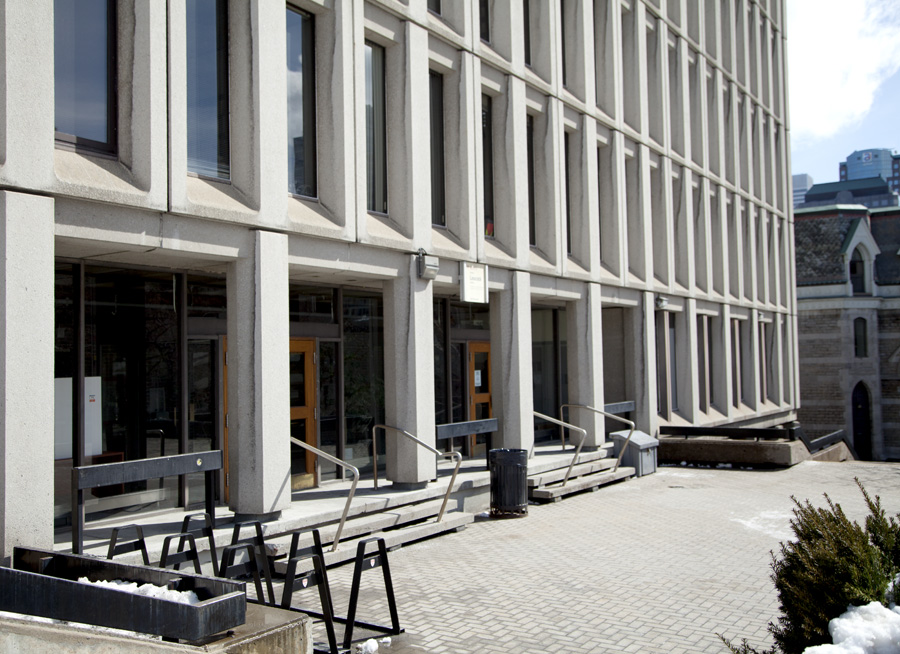The Leacock Building may soon be under renovations to improve usable student space because of the Arts Undergraduate Society (AUS). On Feb. 10, the AUS Legislative Council held their bimonthly meeting, during which they discussed these renovations as a potential use for AUS reserve funds, and approved a motion to require beneficiaries of AUS funding to publicly acknowledge the funding.
AUS President Jacob Greenspon presented an update on the Leacock Space Project, an initiative that began in 2014 through discussion by the AUS executives on how to use the estimated $265,000 in reserve funds. AUS has been working with the McGill Space Project, a student led group working to optimize the use of space on campus. In addition, AUS paid McGill Campus Space and Planning a $3,000 consultive design fee to look at redesigning five spaces in Leacock.
“The study encompasses the corridors and lobby of the first floor of the Leacock Building, as well as the mezzanine space on the second floor and the open space in the basement at the foot of the staircase, [as well as SNAX]” Greenspon said.
Design changes would be aimed to create informal seating areas, including new furniture, a new floor finish to delineate the space as well as additional power outlets. The proposal requires the removal of some computers from the areas on the first floor under renovation. This prompted concern from Anthropology Students' Association (ASA) Vice-President (VP) External AItai Gibli.
“In my experience I always see students using those computers presumably not for Facebook,”Gibli said. “Isn’t that something that should be prioritized over aesthetics?”
According to Greenspon, student needs will be taken into account when modifying these spaces.
“I think students usage of those computers has gone down a lot, and I don’t think cutting all those computers is necessary, but maybe five [computers] will be enough,” Greenspon responded.
AUS VP Academic Gabriel Gilling questioned how much student consultation was considered for these design choices.
“I was wondering the extent to which students were consulted on what they wanted to see be improved in Leacock,” Gilling said. “I know there's been talk within the Faculty but have students been able to voice what they want to see?"
Greenspon responded that the process had been mostly executive-led.
"I was not on the executive last year so they can give better answers to this question, but my understanding was that this was an executive led issue,” Greenspon explained. “There was consultation especially with and the wider student body, but this was mostly an executive led issue.”
AUS is also considering renovations to SNAX.
“There’s three possible subproject there which are a new booth for SNAX, including a glass display case, and an enclosure for the recycling bins under the stairs because right now they’re all over the place, and some sort of formal seating spaces,” Greenspon said. “There is a caveat here, that the recently signed Memorandum of Agreement (MoA) Letter of Permission states that SNAX may not have a seating area [….] But [the MOA] expires in 2016, so it may be an option in the future.”
While the five projects do not need to be undertaken together, the estimated total cost is $242,300. However, the final cost can vary as much as 30-50 per cent from the estimate according to Greenspon. The presentation highlighted four potential sources of funding besides the AUS reserve fund, the Arts Undergraduate Improvement Fund, the Faculty of Arts Info Tech Fund and the Arts Computer Lab Fund. Greenspon also mentioned the AUS Council's ongoing interest in renovating the Arts Lounge.
“There has been a lot of talk on the executive Council about doing some sort of renovations to the Arts lounge, and I think it’s worth considering that both these projects will compete for funding […] as well it being hard for executives to handle this many projects at one time,” Greenspon said.
Council also voted to pass a motion to amend the financial bylaws.
“This is a straightforward and simple movement, we’re just making a small amendment to the financial bylaws so that any unit that receives any sort of funding that [AUS] is able to give out,” Gilling said. “We just ask for public recognition that the fund comes from us. There two dual objectives in advertising our funds [and] through receiving recognition that we are funding it.”








